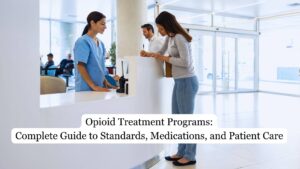Vivitrol® is an FDA-approved prescription medication used to treat opioid use disorder (OUD) and alcohol dependence. It is given as a once-monthly injection in a clinical setting and is designed to help reduce cravings and prevent relapse. For people considering medication-assisted treatment (MAT), understanding Vivitrol’s safety profile is essential in deciding if it is the right option for their recovery plan.
This article explains how it works, outlines its potential side effects and risks, and summarizes what research says about its effectiveness so you can make an informed decision.
What Is Vivitrol and How Does It Work?
Vivitrol is an extended-release injectable form of naltrexone, a medication that works by blocking opioid receptors in the brain. This action prevents opioids from producing their euphoric effects, reducing the risk of relapse for people in recovery.
For individuals with alcohol use disorder, it helps by decreasing cravings and reducing the likelihood of heavy drinking episodes. It also eliminates the need for daily medication, taking away the temptation to miss doses and making it easier for patients to stay consistent with recovery.
Clinical research shows that this alcohol abuse medication can support long-term abstinence and reduce relapse rates when combined with a comprehensive Vivitrol treatment plan that includes therapy, counseling, and peer support. Patients often report fewer cravings and better focus on recovery activities, helping them stay engaged in the healing process.
Common Side Effects
Vivitrol is generally well-tolerated, but mild side effects can occur. The most frequently reported include temporary pain, redness, swelling, or itching at the injection site, which usually resolve within a few days. Other possible effects include headache, dizziness, fatigue, nausea, and mild flu-like symptoms as the body adjusts to the medication. These reactions are typically short-lived and do not require discontinuation of the drug.
Monitoring and reporting any side effects to a healthcare provider is an important component of safe care. Severe, persistent, or disruptive reactions should be evaluated promptly. Clinicians may recommend strategies to manage discomfort, such as using a cold compress on the injection site or adjusting the regimen if necessary. Early communication with the care team helps ensure that any complications are addressed quickly, supporting consistent adherence to the treatment schedule.
Serious Risks and Precautions
While Vivitrol is generally safe under medical supervision, it carries important precautions. Because it blocks opioid receptors, tolerance decreases during the course of therapy. If someone resumes opioid use after stopping Vivitrol, they may face a high risk of overdose even at doses they once tolerated.
Patients must be completely opioid-free for at least 7 to 14 days before starting the medication to avoid precipitated withdrawal, a sudden and severe reaction. In rare cases, naltrexone may cause liver injury, so periodic liver function tests are recommended. People with acute hepatitis or liver failure should not use this medication.

Who Should Not Use Vivitrol?
This medicine is not appropriate for everyone, and certain medical conditions or circumstances may make its use unsafe. Individuals who are physically dependent on opioids or experiencing acute withdrawal should not receive naltrexone, as it can trigger severe precipitated withdrawal.
It is also contraindicated for those with a known allergy or hypersensitivity to this medicine or its ingredients, as well as individuals with active liver failure or acute hepatitis. To ensure safety, healthcare providers typically perform a urine drug screen or a naloxone challenge test before initiating treatment to confirm the patient is not engaging in substance abuse.
Managing Safety and Maximizing Effectiveness
Consistent medical supervision is essential for ensuring patient safety, beginning with regular follow-up appointments to monitor progress, manage side effects, and perform routine liver function tests.
Creating a personalized relapse prevention plan with the care team helps patients stay focused on recovery goals, while keeping naloxone available adds an extra layer of protection in case of accidental opioid exposure or overdose.
Final Thoughts from Raise the Bottom
Vivitrol is widely recognized as a safe and effective option for treating opioid and alcohol dependence when used under careful medical supervision. Although there are potential risks — including an increased risk of overdose if opioids are used after discontinuing treatment — these risks can be greatly minimized through thorough screening, consistent monitoring, and clear patient education.
At Raise the Bottom, we provide Vivitrol-assisted treatment as part of a comprehensive opioid addiction rehab program in Idaho. Our approach combines medication with counseling, behavioral therapy, and long-term support to give patients the tools they need for sustainable recovery. Through the integration of medical care with emotional and behavioral support, we help individuals build a strong foundation for lasting sobriety and improved quality of life.






